CURENT Spotlights
Student, Industry and Research
March 2015
Student Spotlight – Micah Till
Michal Till writes about his internship and adventure in Switzerland
Chocolate, Cheese and the Alps
by Micah Till, March 2015
Before this past fall, if you had asked me what comes to mind when someone says “Switzerland,” I would have said chocolate, cheese, and the Alps. While I still think of those things, I think of much more as well.
In August I said goodbye to Tennessee and got on a plane in Chattanooga. About 12 hours later I landed in Zurich and was faced with deciphering the SSB ticket system. While I knew enough High German to ask directions and buy staple foods, I knew almost no Swiss German (comparing the two “Germans” feels like comparing Spanish and Italian). Now I can recite the zones needed to get almost anywhere from Baden, Switzerland by heart, but that day I made an unfortunate attendant spend almost ten minutes explaining the system. However, she ended up selling me a Gleis 7 card so I feel both of us went away happy with the outcome.
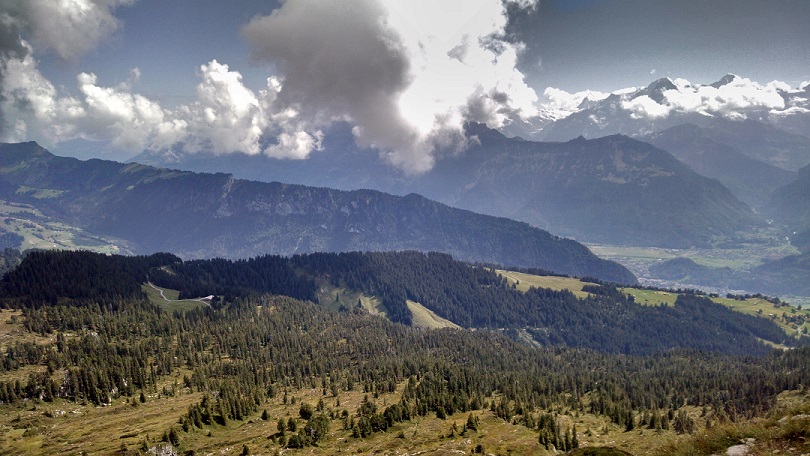
View from Niederhorn
When I first arrived at ABB’s research center in Baden-Dättwil, I did not know what to expect. It was my fifth day in Switzerland. I had secured my apartment, food and a new bank account, but my broken High German was strained to the limit and I could not even say “hello” correctly in Swiss German yet. Thankfully, the research center uses English as the official language. It soon became clear that for the engineers and programmers from all over the world, English is the only common language whether the company choses to recognize it as such or not. The sixteen interns in my department represented ten countries. The full-time employees double that number.

Micah Till (1st on left) and the ABB Fall 2014 interns
Both the Automation Department as a whole and the more focused Utilities Solutions Group work on a wide array of projects so, in addition to coming from different cultural and different culinary backgrounds, we are all specialized in completely different areas of electrical and computer engineering. I worked on several projects, but my main task was the creation of synchrophasor data and latency visualization tools. Before my arrival, my supervisor used the command line to debug the PMU tools he develops. To keep track of several hundred data streams, he would write everything out to a text file and import the data into MATLAB for graphing. Doing this required waiting until the run was complete so I was given the job of creating a real-time interface using JavaScript and PHP that could be displayed using any popular browser.
The main problem going into the project was obvious - this was my first experience with JavaScript. As it turned out, one of the computer science students interning with the department needed to simulate a 500-kV transformer for part of her project so we worked each other through some of the sticky points. (Apparently, the simple symbols we EEs use on everything can seem cryptic to someone who never took Circuits I.) With her help and the frequent use of Google, I learned quite a bit about designing web pages over those four months. Add in my crash course on PHP, a refresher on C++ structures and a reading of the SQLite documentation, and I was happy to take a break from the voltage stability calculations assigned to me from time to time. I am sure that optimization opportunities will present themselves to anyone making future modifications to my code, but the end result was a functional tool for real-time data viewing that fit the design requirements.
After work I would return to my studio in Baden or take the train to Zurich. Sometimes in the evenings all the interns from our group would get together for dinner or to explore Switzerland. On the weekends we would visit attractions like Europa Park, Christmas markets, or the Frey Chocolate Factory. At other times we might gather for fondue or hiking.
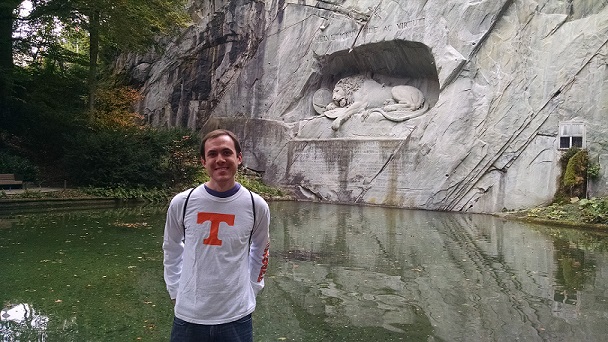
Micah in front of the Lion of Lucerne
At least every other weekend, I got up before the trains were crowded and went hiking in the Alps. Contrary to my perception of them beforehand, they are not constantly covered in snow – in fact there was only snow on the ground the last month I was there. My Gleis 7 allowed me to ride back home for free after 7:00 p.m. and I took full advantage of it. Almost any weekend I did not visit an Alp, I could be found exploring cities such as Geneva or Bern. Quite a few people felt the need to tell me where “the most beautiful place on earth” could be found, but since everyone told me somewhere different, I found it hard to believe they could all be right. One friend though, told me a story of an Irish monk, St. Beatus, who ventured into a mountain cave and defeated a dragon to convince the people living nearby to convert to Christianity. The town of Beatenberg is named after him and the monastery he built at the cave is open to visitors – oh, and by the way, it’s the most beautiful place on earth. Stories like this, full of history and character, are what I loved about exploring Switzerland.

View from St. Beatus Hohlen
So what comes to mind when someone says “Switzerland?” Still chocolate, cheese and the Alps, but also hardworking men and women who prize efficiency, value life and hold a rich history.
Bio: Micah Till is a PhD candidate under Dr. Yilu Liu. Although he calls Chattanooga, Tennessee his home town, he was originally born in Knoxville. His interest in EECS, in general, and power systems, specifically, appears to be a hereditary condition.
--------------------------------------------------------------------------------
Jan. 2015
Research Spotlight – CVSR demo
ORNL and CURENT have Successful Project Demo with ARPA-E
On Dec 8th, 2014, Researchers from CURENT and Oak Ridge National Laboratory (ORNL) traveled to Waukesha, WI to test and demonstrate a new type of power flow controller for transmission grid applications. The demo took place at an SPX Transformer Solutions manufacturing plant. The team successfully demonstrated continuous impedance control of a 1500 A, 115kV reactor using a special reactor designed by ORNL and SPX, which is controlled by a power electronics converter built locally at ORNL and CURENT. This research project is sponsored through the ARPA-e GENI program, and recently earned an R&D 100 award.
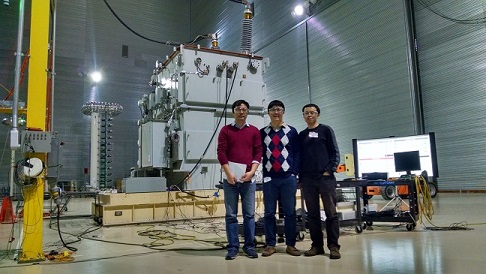
Jinjxin Wang, Sheng Zhang and Zhi Li (L to R) in front of reactor
The control of power flow in power systems is a major concern for utilities and system operators. But full power flow control has been prohibitively expensive, requiring large numbers of complicated and costly devices. The magnetic amplifier project has produced the Continuously Variable Series Reactor (CVSR), a simple, magnetic-field-based device for power flow control that has substantial improvements in cost and complexity.
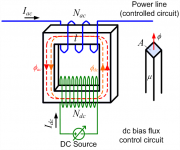
Basic electromagnetic principle of CVSR
The CVSR operates by adding an additional winding supplied from a DC power source to a traditional iron-core reactor. By supplying DC current from the power electronics-based DC source, the team was able to demonstrate continuous control, of the reactor impedance by gradually saturating the core. The team at CURENT is responsible for the power electronics design and control. This design is quite challenging due to high levels of both active and reactive power required, and minimal opportunity for cooling of the converter. At the Dec 8th demonstration, the first prototype of the power converter operated successfully up to full AC power flow, and over a wide range of controlled reactor impedance. Future CURENT work on this project focuses on improved robustness, control, and thermal management of the converter.
The project is led by ORNL Researcher Dr. Aleksandar Dimitrovski. He gave a CURENT seminar on this project in Sept. of 2013. The CURENT team that supported the demo included post docs Sheng Zheng and Jinjxin Wang, Ph.D. student Fei Yang, and faculty members Fred Wang and Daniel Costinett.
---------------------------------------------------------------------------------
Dec. 2014
Student Spotlight - Summer Church
Summer Church, a sophomore in Electrical Engineering and a CURENT ambassador, has been chosen to receive an IEEE PES Scholarship. The scholarship runs three years and Summer is one of 184 scholars to receive this prestigious award. She says, “"I feel honored to have been selected as an IEEE Power and Energy Scholar and would like to thank IEEE and The University of Tennessee for their support in my aspirations to become an electrical engineer. Opportunities like this scholarship and the CURENT research center at UT continually encourage me to pursue a career in the electric power industry and to advance in this field of study. This scholarship has opened up several opportunities, such as connections to people in industry and special society memberships for IEEE Power and Energy Scholars. I would like to encourage others to apply for this scholarship as well, especially those who are highly interested in power and energy."
Read more about Summer and her scholoarship.
Read the PES Scholar Profiles.
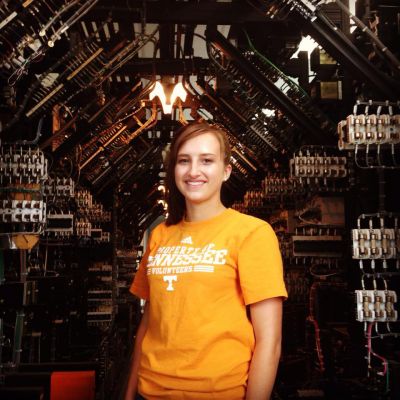
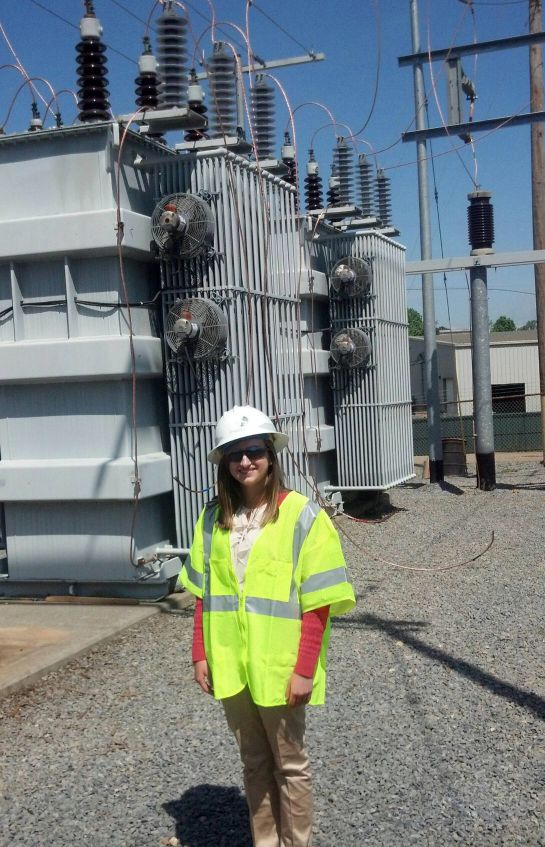
-----------------------------------------------------------------------------------
Nov. 2014
Industry Spotlight – Wanda Reder
The October Industry Seminar featured Wanda Reder, who is the Vice President of the Power Systems Solutions at S&C Electric Company. Ms. Reder's talk was titled the Future of the Grid and discussed the significant transformations the U.S. electric grid is currently undergoing from the introduction of digital technologies, policies encouraging the growth of renewable and distributed energy resources, and increasing engagement of electricity customers and businesses in both managing and producing energy.
Click to read more and view the video.
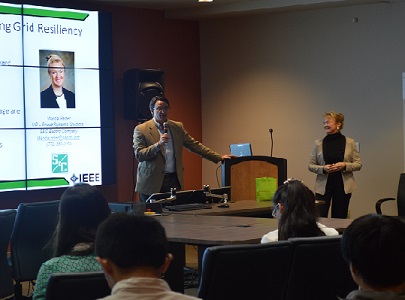
Tom King introduces Wanda Reder

